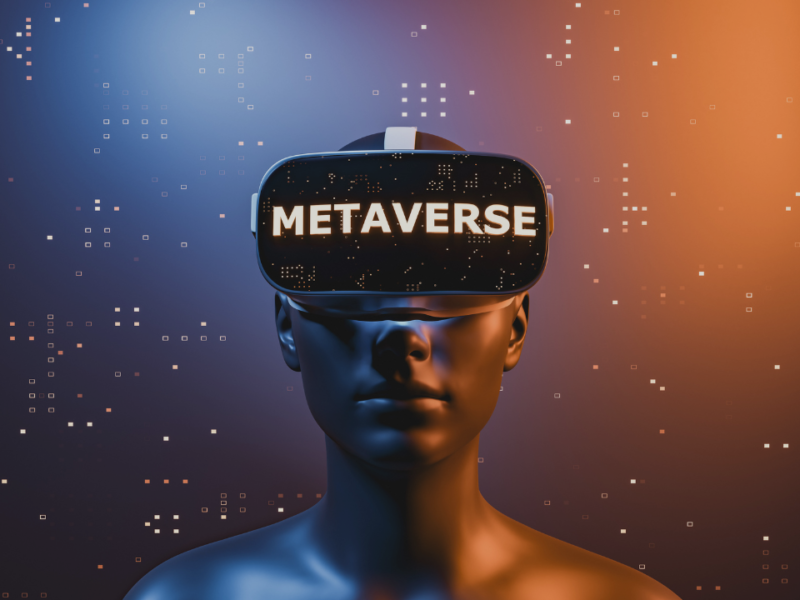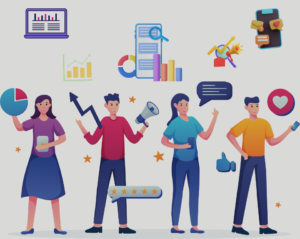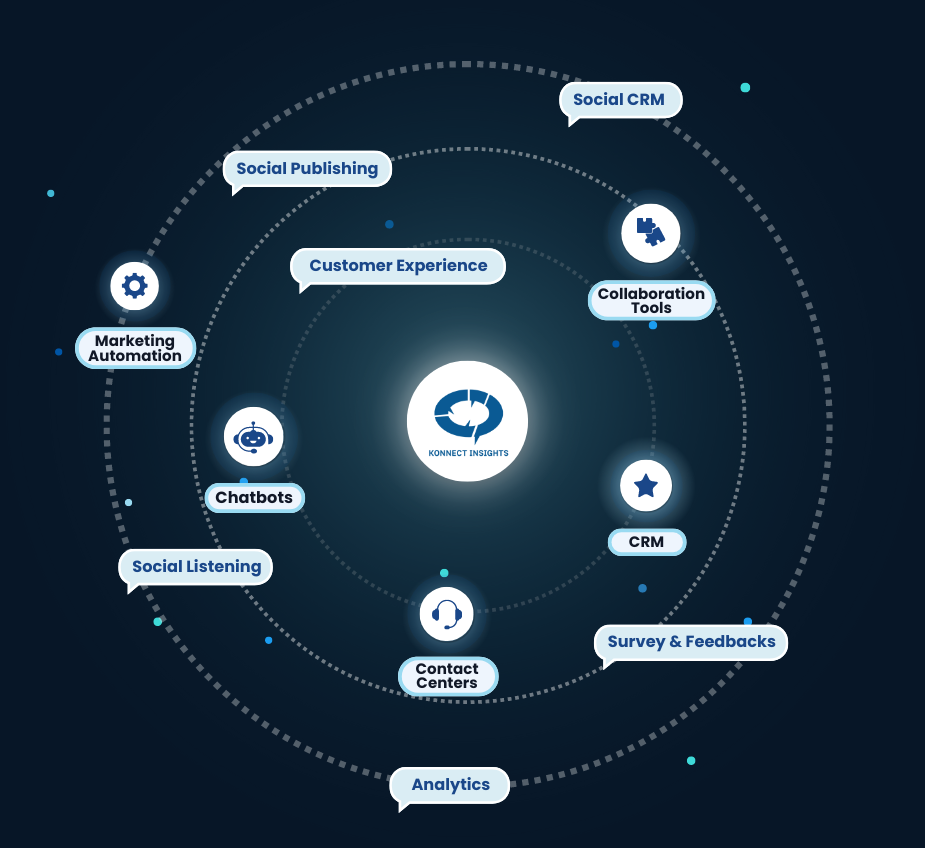TABLE OF CONTENTS
- Current Landscape of Metaverse, Web 3.0, and Marketing
- Overview of the Metaverse and Marketing
- Major Drivers of Metaverse Growth
- What is Web 3.0?
- Traits of the Web 3.0 Metaverse
- Virtual Worlds: A Modernized Brand Market
- Key Components of Metaverse Marketing
- The Metaverse is Here!
The Metaverse is here, dawning on a new wave of modernization and digital acceleration. Read the latest research on how brands can embrace the Metaverse, Web 3.0, AR/VR, and virtual worlds for efficient user experience management.
Current Landscape of Metaverse, Web 3.0, and Marketing
Change is coming, and history states that change is nature’s delight. The introduction of the intranet almost 30 years ago created a similar global renaissance as widespread digital adoption today. Digitalization is accelerating at such speeds that many current digital business systems are being outpaced. For critics who do not understand the digital transformation of business models, the Web 3.0 revolution is here to nurture your faith in technological advancement.
Much like embracing the internet, or Web 1.0 from the 90s, and the social media revolution, or Web 2.0, Web 3.0, and the metaverse are altering the way humans interact with technology and among us. The prime advantage of uprooting the barriers between geographies, demographics, and cultures is that a globally inclusive technology can thrive with industry and people’s needs. Fortune favors the brave, and appreciating innovation means participating in and realizing the uses of technologies like Blockchain, Cryptocurrency, the metaverse, Web 3.0, and how businesses are altering their approach to digital agility.
When the internet was introduced in the 1990s, mainstream audiences believed that the beginning of a new era was dawning. Technology has always evolved and altered the way people worked, interacted, and shaped their lifestyles. Broadband and dial-up modems soon became a thing of the past, and leaner, faster technologies are easily accessible.
Emails replaced postal services, and at the fingertips of internet users is the latest information and news. Performing complex tasks like video editing, music mixing, sales, customer support, and lead generation is all done at the touch of a button, or via interactive applications.
Live communication across international boundaries is now faster than ever. eCommerce giants like Amazon and tech giants like Google have introduced revolutionary technologies like cloud base services and Ai powered platforms. The use of autonomous cars and extensive IoT development has reshaped industries. The life-saving properties of telemedicine and pharma research are examples of how complex algorithms are used to design systems that produce breathtaking research, discovery, and novelty.
Digital marketing has influenced modern business, by emphasizing digital media as a means to accelerate business transformation. The internet has become an interconnected powerhouse of information that can be universally accessed to further the pursuit of innovation, and discovery.
Connecting people across the globe, the Web 3.0 revolution is set to surpass the Web 2.0 era, when the internet was in full swing, indicating that the way we perceive technology is about to change. According to a Pew Internet Project survey, the majority of internet users between 2005-2006 were under the age of 30. 15 years later, 50% of global internet users are aged 35 or more.
The number of internet users has increased from approximately 1 billion to 4.5 billion in this window of history. The use of social media platforms like Facebook, Twitter, and Instagram plays an important role in the progression of modern marketing techniques, business models, and consumer experiences.
User-generated content is thriving on the internet, and with the augmented reality and virtual reality properties of Web 3.0 in the Metaverse, it is undisputed that a holistic and perceptive transformation in human-technology interactions is here. The increased connectivity and communication of Web 3.0 complement the worldwide adoption of technologies to streamline human efforts and make machines take on complex tasks more efficiently.
Accelerating and integrating mobile solutions with the cutting-edge properties of Web 3.0 and the Metaverse introduces refined means of communication, collaboration, and business development. Audiences of today benefit from personalized experiences, whether working, gaming, shopping, binge-watching, or interacting with peers. The current modernization of business inspires intuitive interfaces for the highly targeted delivery of interactive digital experiences.
Overview of the Metaverse and Marketing
The global pandemic of COVID-19 accelerated digital adoption, owing to the need for streamlined governance and operational solutions. The demographics of internet users have also evolved, with Gen X and Millennials set to make up half of all consumers in Asia by the year 2025. Marketers are eager to win over this consumer class with technology that resonates with their interests and desires. The focus on what’s ‘New and Next’ is needed to match the demands of the ‘Now.’
An interconnected virtual world based on Web 3.0 technology is an environment in which users don’t distinguish between physical and digital, setting expectations high for consumer patterns across diverse verticals. The modern consumer expects their friends, consumables, goods, and experiences to be connected virtually, with gear that can bridge the gap between a physical and digital reality. This interconnected, live, and persistent virtual world is referred to as the metaverse.
Imagine a world where you can get the feel and texture of designer clothes from the comfort of your home, from a brand halfway across the world, without having to travel or physically be present. You may use AR gear and VR applications to build gadgets that can mimic the human senses at the touch of a button. This is what the Metaverse and Web 3.0 promise to businesses and consumers.
Industry Leaders Speak!
“The Metaverse is a ‘successor state’ to the modern internet, with all the same content but fewer limitations as to where and how that content can be accessed. Current online platforms allow users to move about somewhat freely within the confines of specific services but limit interoperability between platforms: you can build anything in “Minecraft,” but you can’t transfer your creations into a “Fortnite” map. The Metaverse will allow users to generate their content and distribute it freely throughout a widely accessible digital world.” – Alexander Lee, Reporter, Digiday
You can now try on clothes in virtual showrooms from the biggest brands, using virtual avatars that detail the size, colors, fit, and texture of your chosen textiles. You can be in your living room playing a world tournament of tennis with optical recognition and motion sensors to replicate your real-time movements.
Doctors perform remote surgeries using intelligent robots and cutting-edge surveillance technology that is accurate, incisive, and intuitively designed. Using in-game advertisements and banners, brands can offer unique and personalized experiences to consumers in the native environments of their favorite games.
As advancements in AR and VR make headway into the future, marketers must leverage the latest data, trends, and platforms to align and aggregate demand for digital experiences at the core of consumerism.
Major Drivers of Metaverse Growth
The growth of interactive technology and the Metaverse is accelerating, owing to widespread demand for refined human-technology experiences. Businesses are leveraging the following key growth factors to tap into the vast opportunity furnished by Web 3.0. Let’s take a look at evolving consumer behavior, with data from Asia-Pacific regions, indicating the shift in consumer behavior and business priorities going forward.
Demographics:
Gen Z, being digital natives, will comprise 25% of APAC’s population by 2025, according to McKinsey research. Along with Millennials, they will account for half of all APAC consumers.
Digital Payments:
Asia’s $2.45 trillion in eCommerce sales during 2020 contributed 62% of the global total. Global electronic wallets rose from 500 million to 2.1 billion from 2017 to 2019. China and India made up 70% of all users, according to Deloitte.
Social Commerce:
26% of all internet users report that they have discovered new products and brands via social media advertisements, and 22% are reliant on comments/recommendations found on social channels, according to a WeAreSocial report.
Video Consumption:
The total video streaming minutes on mobile devices grew by 30% between Q1 and Q2 of the year 2020, reports Intelligence Insider.
Mobile-First:
Among the top 10 mobile markets worldwide, Asia occupies six of the top 10 spots China, India, Indonesia, Japan, and Vietnam. Southeast Asian countries occupy 2 of 6 of these consumer bases. Mobile is the medium, and Metaverse is designed to augment user experiences, influencing lifestyle choices and consumer patterns.
90% of all consumers in APAC regions use smartphones to access information and services via the Internet. This means that approximately 4 hours a day are spent on apps, which is 1 hour longer than any other region in the world.
What is Web 3.0?
The Metaverse ushers in a range of live, interconnected virtual experiences, powered and characterized by inclusive trends in digital transformation. For progressive marketers, the Metaverse includes social communities, digital transactions, and gamification.
Some of the key components of the Metaverse and Web 3.0 include blockchain technology, digital products, cryptocurrencies, virtual avatars, and non-fungible tokens (NFTs). The Metaverse embodies the optimal range of functionalities of Web 3.0, comprising the imminent next-gen internet services umbrella.
Leveraging Machine Learning and AI-powered interfaces, a decentralized, connected, immersive, and open-web-based experience is the crux of the metaverse. Metaverse and Web 3.0 present immense opportunities for brands to clearly define their role in owning, creating for, and collaborating with other brands, and consumers. Experts identify the new age of customer experiences as AI-driven, highly personalized, and interactive technology-enabled experiences.
Traits of the Web 3.0 Metaverse
The generally accepted characteristics of the metaverse are well-known, as the inclusion of augmented reality and virtual reality gradually makes their debut in our daily lives. Key characteristics or traits observed by the rise of the Metaverse are observed by experts and researchers, as outlined in the following statements.
Social:
Being able to share virtual experiences and environments as a whole with other parties, built within a world with key elements to signify a sense of presence.
Live and Persistent:
The metaverse is to be a parallel reality that co-exists in real-time and is never-ending.
Hardware Agnostic:
Digital worlds are interconnected and accessed via many devices, hardware, and locations using secure and responsive interfaces. Users discover that within these worlds, everything from extended virtual and augmented reality to tablets, mobile devices, and wearables is interconnected. The age of IoT introduces life-altering and revolutionary capabilities of digitalization.
Economic Fertility:
Digital environments will be able to base fully-functional modern economic systems on blockchain and cryptocurrencies, creating immense opportunities for businesses to buy, sell, invest, and claim authorized ownership over valuable digital assets and media.
User-Generated Content:
The metaverse is expected to be heavily driven and succeeded by the creators of content and experiences that are tailored and modified by users of the Metaverse themselves, creating an open world of opportunity.
Interconnected Worlds:
Users can intuitively alter between diverse virtual and augmented realities, bridging the gap by combining elements from one world with the next, creating an interactive and interconnected user journey. Digital worlds can also influence and interact with the physical world via access points like hybrid digital and physical products and devices.
Virtual Worlds: A Modernized Brand Market
The refined marketing ecosystem of Metaverse thrives on brands that create and nurture online experiences using the inventive characteristics of Metaverse. Key components enabling user-generated experiential value include virtual avatars, digital collectibles, and products like NFTs, augmented reality, and virtual programming, among others.
Using digital assets like NFTs (Non-Fungible Tokens), marketers can go beyond the artistic and esthetic to create loyalty programs, and exclusive events and secure the authenticity of transactions. Goods like NFTs also have sentimental and functional value, like the authentication of digital assets, building awareness, and ticketing, among other uses.
Between owner and consumer, IPs are used to reinforce the security and ownership of digital assets, minimizing risks that would otherwise arise from easy access to interconnected experiences. By personalizing the user experience through verified digital experience management, the Metaverse is an open world that refactors the way we perceive and experience life.
| Industry Leaders Speak“Metaverse isn’t a thing a company builds. It’s the next chapter of the internet overall.” – Mark Zuckerberg |
Key Components of Metaverse Marketing
- Avatars
Avatars are virtual extensions of personalities and people, represented in the digital world. In the Metaverse, a population consisting of avatars would resemble that of the actual human race. Today, avatars exist within closed worlds, on individual platforms like Facebook, Instagram, Genie, etc.
The focus of innovation in Metaverse technology will be to make avatars universally accessible across an open-world platform, creating limitless possibilities for marketing and promotional efforts. Successful deployments by Louis Vuitton, Christian Louboutin, and Gucci avatars are already making their way to the market.
Historically, the use of login IDs and personal profiles to access websites is about to be replaced with avatars. Many Gen Zers already believe their digital avatars are extensions of themselves. An avatar is programmed to have its attributes like preferences, digital assets, brand likeability, etc. through the advancement of AI tech.
- Collectibles like Digital goods and NFTs
An avatar is not required to buy digital assets or trade on public platforms. An excellent example of digital assets launched by brands is the NFT released by Anheuser-Busch, which invited people to access the virtual merchandise of a horse. The NFT horse could be integrated with a virtual horse race. Coca-Cola also dropped a loot box in July 2021, comprising digital wearables, and collectible branded goods, and managed to gather $500,000 for charity.
In an attempt to enrich the user experience on Web 3.0, virtual environments and platforms will use NFTs and digital asset trading. Exclusive access to content and tokenization of digital assets will accelerate decentralization via secure blockchain technology.
- Virtual Programming
The Metaverse today showcases cultural programs just as much as the real world does. Behind closed doors, these events are virtual programs integrated with a timeline of their own, featuring upcoming events, live streams, and interactive experiences.
Virtual programming like concerts, fashion shows, and movies adds tangible value to branding and consumer engagement. Metaverse grants access to Gen Z consumers, who can now experience virtual and augmented reality, uninterruptedly via their devices. It would be as though there was no difference between the real world and the virtual world – engaging in virtual and augmented realities.
- Augmented Reality
Augmented reality is continuously setting new frontiers for Metaverse development. Examples of Phygital engagement refer to virtual engagement using responsive wearable software. Among brands, AR is a driver of commercial benefits. Shopify’s research states that products offered as 3D/AR media have a 95% conversion rate, compared to those without 3D/AR.
Examples of AR/VR merchandising are:
Gamified Physical Experiences:
The use case for Pokemon Go is an early example of AR/VR prominence. Bridging the gap between physical and virtual environments, new gamified worlds are emerging. For brands, this means a lucrative opportunity to showcase their expertise in engaging consumers via interconnected virtual worlds.
Virtual Makeup:
Brands like L’Oreal are quick to adopt AR/VR tech for customers. The beauty brand launched virtual makeup using AR filters designed by AR industry player Modiface. Spread across social and other media, Instagram, Zoom, and Snapchat were some of the chosen channels.
AR/VR Retailing:
With this revolutionary tech, brands like Adidas, Gucci, and Warby Parker all built AR experiences for their consumers to try products virtually, before making a purchase decision. AR tech opens doors to limitless possibilities for customer mobility, accessibility, and interaction.
The Metaverse is Here!
Embracing that virtual worlds, digital assets, and the Metaverse are undoubtedly revolutionizing marketing models, entrepreneurship is also being redefined. Brands seeking to engage Gen Z are offered immense scope to innovate the user experience using a creative approach personalized to their intents.
This paper aims to align marketing methodologies with the futuristic evolution of the Metaverse and augmented realities. Brands positioning themselves in the Metaverse will determine the future of the digital age.
With more interactive and inventive means to access content, users will find parallel worlds at their fingertips. Finding that the Metaverse is already here, should inspire a rush of hope and optimism for modernization.
Social spaces with gamified simulations, NFT-powered free trade, decentralized currency, and virtual merchandising expand the development of the metaverse. Brands can engage a broader audience and narrow their marketing strategies to the most detailed approach required to compete in their niche.
While it may seem surreal to many, the metaverse’s evolution will spark new possibilities for innovation. Bridging the gap between the digital and the physical, pioneers like Tencent, ByteDance, Unreal Engine, Sky Mavis, Roblox, Decentraland, Enjin, and Rally are all promoting AR/VR experiences via gamification, blockchain, NFTs, and virtual worlds.
The widespread adoption of Metaverse will furnish brands with the means to facilitate authentic, personalized, and highly intuitive interactions with consumers. Cultural, historical, and societal milestones will be celebrated as momentary achievements preserved in the unending loops of augmented and virtual realities.
Embracing the Metaverse proactively will ensure the success and evolution of branding, trickling down to every touchpoint of the user journey. Key industries will rely on effective digital asset management to retain their loyal consumers. The Metaverse is here; change is inevitable, but delight at this cherished chapter in human history.
Connect with us!
Konnect Insights is a technology catalyst and leader, publishing research on the latest trends in global digital systems. Stay aboard the wave of transformation and keep up with modernization by our side.












